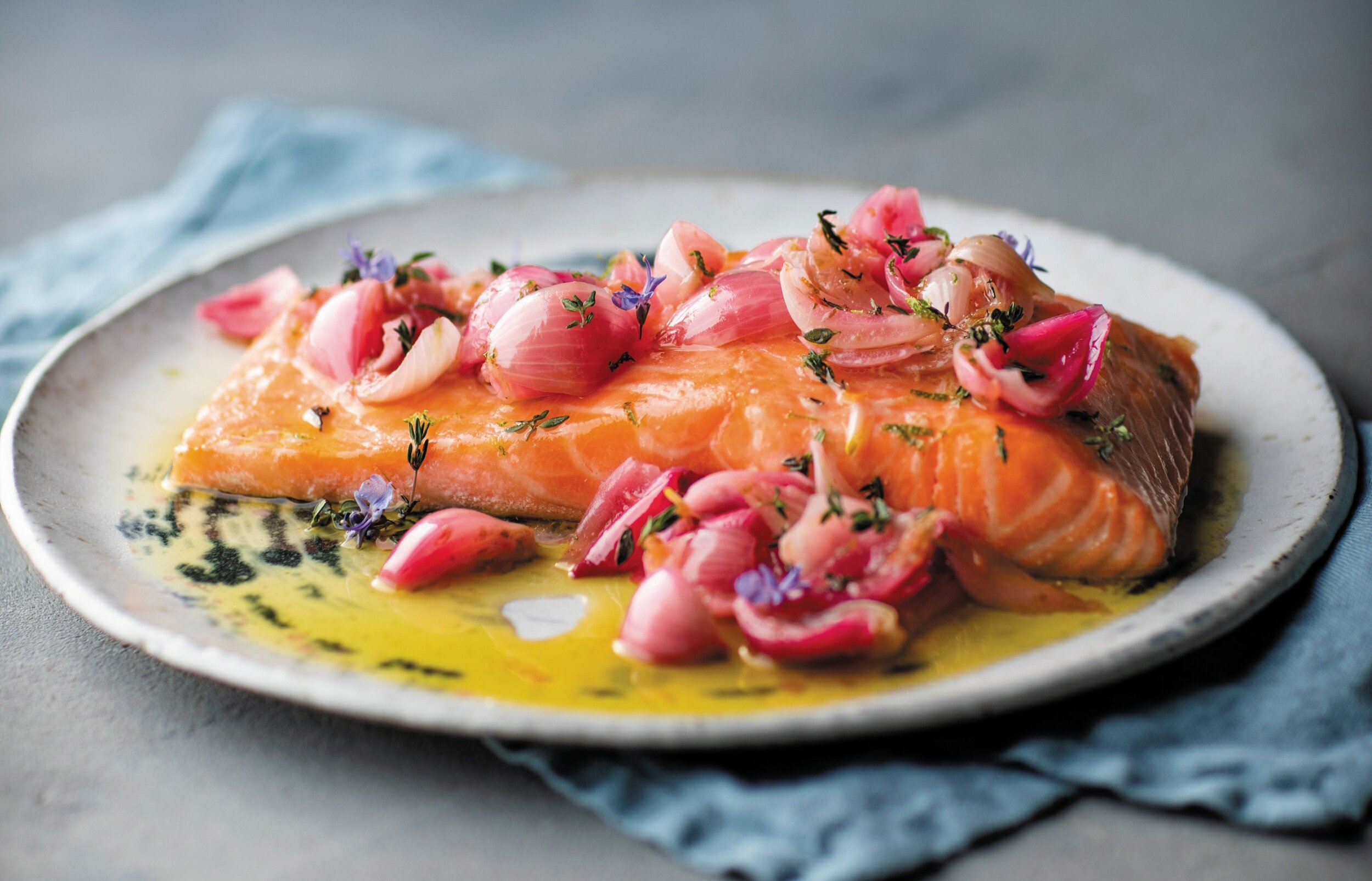Slow-Cooked Salmon with Ti Malice Sauce
Serves 6
Slow-cooked salmon was my initiation to the perfection-through-simplicity ethos at the famed Jean-Georges, where I had my first job in a professional kitchen. Today, I still cook salmon this way, and you won’t believe how easy it is to turn the ubiquitous, frequently overcooked fish into a tender treat.
Something this rich needs acidity to shine, so I look to sos ti malice, named for a mischievous character from Haitian folklore. The story goes: Ti-Malice was tired of his friend Bouki coming over for lunch, overstaying his welcome, and eating all his food, so the trickster made a sauce so fiery that it would surely make Bouki run screaming from his house. And Bouki did indeed run into the street—shouting about how much he loved Ti-Malice’s sauce.
One part of the story is definitely true. The Haitian condiment, a pickle that doubles as a sauce, is that good. Mine has plenty of fruity heat from Scotch bonnet or habanero chiles, the zip of citrus and vinegar, and a little crunch from red pearl onions. Peeling and separating the onions into tiny petals takes time, but the result is gorgeous. But sure, shallots cut into 1/4-inch half-moons work great, too.
INGREDIENTS
For the Ti Malice Sauce
3 cups red pearl onions
1 1/2 tablespoons kosher salt 3 limes
1 large Scotch bonnet or habanero chile, very finely chopped
6 tablespoons white vinegar 6 tablespoons extra-virgin olive oil
1 tablespoon fresh thyme leaves
For the Salmon
One 2-pound salmon fillet
2 teaspoons kosher salt
3 tablespoon extra-virgin olive oil
MAKE THE TI MALICE SAUCE
Soak the pearl onions in a small bowl of warm water for 20 minutes to help loosen their skins. Take a few pearl onions at a time out of the water, then trim the tips and bottom nubs and use a small paring knife to peel off the skins. When you’ve peeled them all, halve them lengthwise.
In a medium mixing bowl, combine the onions and salt, toss well, and let them sit for 15 minutes to soften. Once they’ve softened, pull the pearl onion layers apart. Use a Microplane to grate the zest of the 3 limes into the bowl, then halve enough limes (1 or 2 juicy ones should do it) to squeeze in 3 tablespoons of juice. Reserve the remaining limes for another purpose. Stir in the chile and vinegar. Let everything sit for about 15 minutes more.
Transfer the mixture to a small pot, add the oil and thyme, and set it over medium heat. Let it heat up (you’re not looking for a sizzle), stirring occasionally, until the onions are translucent and lose their harsh raw flavor but still have a slight crunch, 7 to 8 minutes.
The sauce keeps in an airtight container in the fridge for up to 2 weeks. Before serving, very gently reheat it (in a small pan or in a bowl set near a hot oven) until it’s a little warmer than room temperature.
COOK THE SALMON AND SERVE
Preheat the oven to 300°F. Evenly season the salmon all over with the salt. Pour 1 tablespoon of the oil in a shallow baking dish and rub to coat the surface. Put the salmon in the dish (skin-side down, if your salmon has skin) and drizzle on the remaining 2 tablespoons of oil so it completely covers the top and sides of the salmon. Bake just until the salmon goes from bright pink to light orange and you see the tiniest white beads on the surface of the fish at the thickest part (the center will register 120°F on a thermometer), 20 to 25 minutes.
Transfer to a platter, spoon the sauce over the salmon, and serve.



